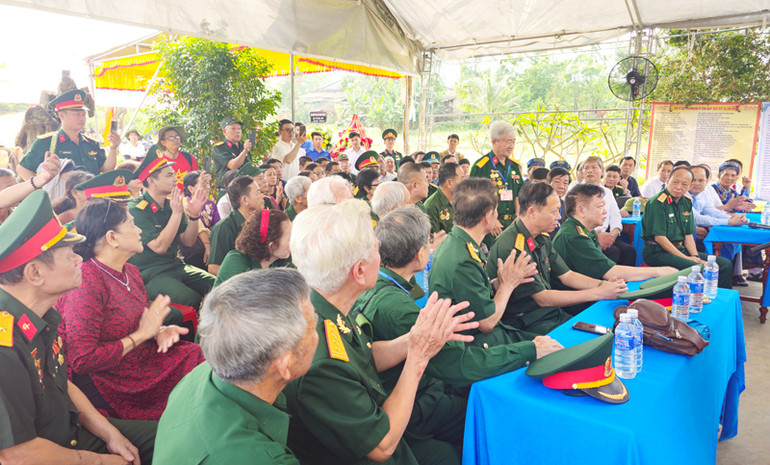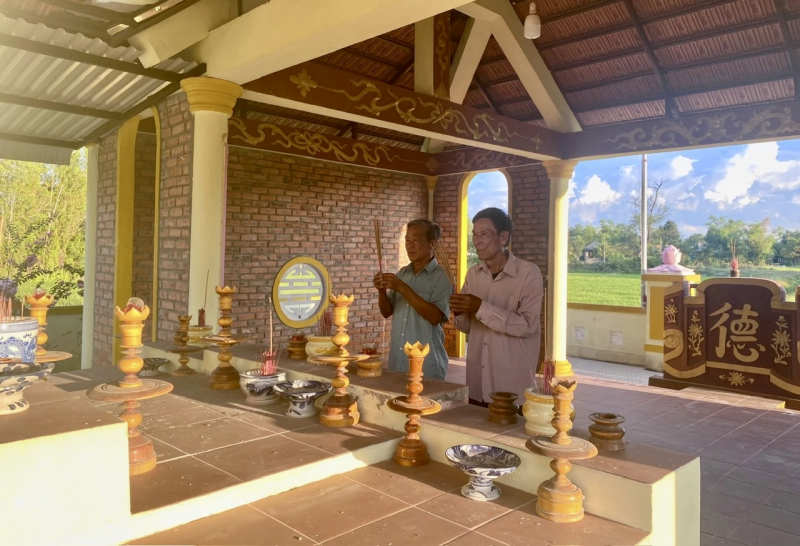More than half a century has passed, the incense smoke still swirls, the drums still resound, so that these two lands have become places to keep the souls of soldiers, become immortal flames that illuminate memories and spread gratitude through many generations.
The epic song from Bau Chua
When mentioning Bau Chua, the people of Thanh hamlet, Cau Hoan village, Dien Sanh commune ( Quang Tri ) often point to the green, tree-filled depression where an ancient pagoda once stood, reflecting in the cool lake. In the midst of that peaceful scene, in February 1966, gunfire and bombs shook the entire village. Regiment 6 - Phu Xuan Group of Tri Thien Military Region was ordered to stop the fierce sweep. Nine days and nights of fighting, enemy bullets plowed the ground, bombs tore the sky, but 66 soldiers still held on, fighting until the last bullet.

When the smoke and fire subsided, the villagers of Cau Hoan quietly went to the pond. The mothers and sisters used their skinny hands to embalm and bury the soldiers right where they fell. From then on, Bau Chua was not only a place name, but also a sacred cemetery, where the homeland embraced the souls of the soldiers.
The Cau Hoan people chose the 8th day of the 2nd lunar month - the day the battle ended - as the anniversary. At first, each family prepared a small meal and lit incense to call the soldiers back. Since 1980, when life gradually stabilized after the country's reunification, the villagers gathered and agreed to organize a common anniversary. Since then, every year, all 55 households in Thanh hamlet have joined hands to contribute, some more, some less, so that the anniversary can be held properly and respectfully.
Mr. Nguyen Duc Dung, Deputy Head of the Veterans Liaison Committee of Regiment 6, said with emotion: “Standing in front of the memorial stele and seeing the children and grandchildren in the village bowing their heads solemnly, I knew my comrades had not been forgotten. They had become spiritual milestones for their homeland.”
From a simple ancient temple, through many rainy and sunny seasons, Bau Chua now has a church and a spacious memorial stele. Incense smoke is always rising. Every month, the villagers clean and cultivate flowers and grass, considering it a sacred task. Mr. Le Minh Khue, Deputy of Thanh hamlet, shared: "The younger generation in the village now understands and voluntarily participates in taking care of the stele, considering it a duty to their homeland". Therefore, Bau Chua's death anniversary is not only a worship ceremony, but also a spiritual festival for the whole community, a place to remind each other of the past and responsibility for the future.
Incense Stick Cau Nhi
If Bau Chua was the epic song of spring 1966, then Cau Nhi, Nam Hai Lang commune (Quang Tri) was the heroic tragedy of the fiery summer of 1972. Cau Nhi bridge on National Highway 1 - the vital artery connecting the North and the South - was the target that had to be destroyed to stop the enemy's counterattack. On the morning of May 26, 1972, Regiment 88, Division 308 received orders to open fire. But the plan was exposed, the battle turned into a fierce hand-to-hand combat. In just one day, 93 officers and soldiers sacrificed themselves right in Mr. Bui Huu Tuan's garden, about a hundred meters from the foot of the bridge.
“The sound of guns, bombs, and screams… all reverberated in my memory like knives. When silence returned, the enemy used bulldozers to bury them in a deep hole,” Mr. Tuan, now 75 years old, recalled, his eyes filled with tears.
Mr. Tuan's parents decided not to build a house on that land anymore. For many years, they dug many times, trying to find traces of the soldiers who had fallen, but the garden was too large, human strength was limited, and they could not know the exact location, so they were helpless. In the end, the couple chose to leave it intact as it was in the beginning, with the belief that one day their surviving comrades would return to find those who had fallen. When his parents passed away, Mr. Tuan kept in mind his parents' instructions, continuing that heart. On the first day of the lunar month, the fifteenth day of the lunar month, Tet or July 27, he always prepared a meal and burned incense in memory. Gradually, the villagers also came to burn incense and share their gratitude. And so, Cau Nhi garden quietly became an "invisible cemetery" - a sacred and peaceful place for the soldiers' souls to reside.

Mr. Tuan's greatest wish is to have a worthy memorial stele. Three months ago, that wish came true when the Policy Liaison Committee of Division 308 mobilized nearly 500 million VND, along with the donation of land by his family, to start building the memorial stele. The stele is 3m high, placed on a sturdy stone pedestal, clearly engraved with the names and hometowns of 61 martyrs who have been verified; the space below is reserved for more than 30 cases whose information is still being added. On the inauguration day, Mr. Tuan said with a trembling voice: "I have waited for this day for more than half of my life. Finally, you have a proper place in the hearts of the people, in the land". Mr. Tran Huu Bac, Chairman of the People's Committee of Nam Hai Lang commune, emotionally shared: "Mr. Tuan sacrificed his own interests, kept the land as a cemetery for more than 50 years, then donated more land to build the stele. That heart makes the whole community admire".
Bau Chua and Cau Nhi – two lands engraved with the blood and bones of their twenties, where the morality of drinking water and remembering its source was forged. In Bau Chua, the young generation of Thanh hamlet considers taking care of the memorial stele as a heartfelt tribute to their fathers. In Cau Nhi, the memorial services under the trees in Mr. Tuan’s garden have become a part of the community’s life. That flame of memory has since been passed down through generations.
Source: https://cand.com.vn/Phong-su-tu-lieu/bau-chua-den-cau-nhi-nhung-manh-dat-giu-hon-nguoi-linh-i780986/






























![[Photo] Off-road racing: Adventure sport, attractive tourism product](https://vphoto.vietnam.vn/thumb/1200x675/vietnam/resource/IMAGE/2025/9/14/45123bd29c884b64934da038d947d344)


































































Comment (0)